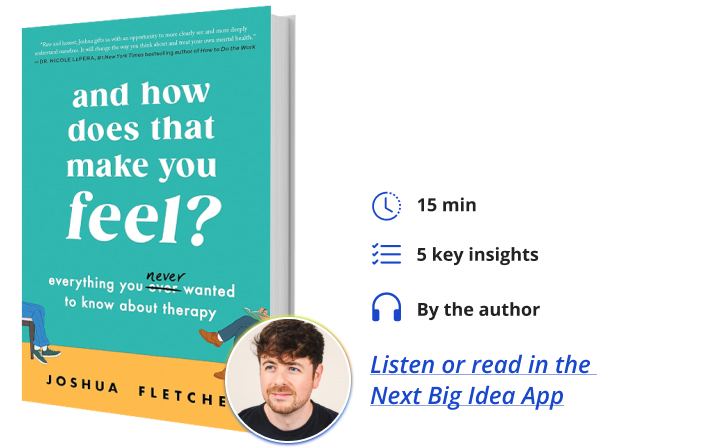Joshua Fletcher is a practicing psychotherapist. He also provides psychoeducation on social media under the name AnxietyJosh. Joshua has personally worked through several anxiety conditions, which inspired him to specialize his career in the field of anxiety treatment.
Below, Joshua shares five key insights from his new book, And How Does That Make You Feel?: Everything You (N)ever Wanted to Know About Therapy. Listen to the audio version—read by Joshua himself—in the Next Big Idea App.

1. Therapy is cool.
I personally put off therapy for a long time. I grew up in a small rugby town in England, where feelings were often processed by running full force into another human being holding an egg-shaped ball. It was only after developing a crippling anxiety disorder, which included panic attacks, agoraphobia, and OCD that I realized the power of therapy and how it could help me grow as a human being.
I’m not a cool person, but it is my passion to make therapy cool, or at least a little more appealing for people who have been averse to it. I’m also passionate about challenging emotional conservatism, which is hiding or repressing emotions in favor of keeping a stern external appearance. For many people, strength is unhealthily measured by the ability to push down or hide from emotions. Picture your stereotypical British guy with a stiff upper lip, sipping tea from his “Keep Calm & Carry On” mug. I challenge the notion of therapy being something you go to when you’re weak.
Therapy is not always straightforward. It’s not a linear process of positive growth where each session ends with you smiling and leaping toward self-actualization. Therapy can be messy, challenging, and extremely confronting—not only for the client but also for the therapist. There is beautiful intricacy and nuance when two strangers come together (one trained in therapy), protected by the sanctity of anonymity, as they both navigate through personal difficulties whilst building a foundation of trust.
2. Mindreading your therapist.
Have you ever wanted to know what your therapist is thinking as they’re staring at you whilst you divulge personal and sensitive information? One of the unique things about my book is that I included my thought processes when working in the therapy room.
Our thoughts are dictated by various facets of our minds and personalities. Take this for example: Imagine the thought process behind ordering a cheeseburger. The biology voice might say, “Yes, put that in my mouth, please.” Meanwhile, the anxious voice may say, “Yeah, but that’s not healthy.” The analytical voice chimes in with, “Consider that we’ve eaten clean all week, and I’m sick of kale smoothies.” Then the critic voice retorts with, “You’re forgetting the cheeseburger you had for breakfast this morning.” These are an example of four voices that squabble in our minds. There are many more voices than that, and they all strive for attention. Other voices include compassion, detective, empathy, escapist, intuition, irreverence, savior, trigger, and volition. Sometimes, they agree; sometimes, they argue; this process of working with clients on their inner conversations is something I wish to share with people and demystify.
“There are many more voices than that, and they all strive for attention.”
In one of the chapters, I find myself with Levi (a scary-looking doorman who has his guard up because he feels vulnerable being in a therapy room for the first time). There’s a moment where we both walk down the corridor to my office. My internal voices start to chatter as follows:
ANXIETY: This guy is scary!
ANALYTICAL: I can see he’s clenching and unclenching his fists.
CRITIC: He’s taking up so much space—you’ll end up mashed against the wall!
EMPATHY: He must be nervous, and people display nerves differently. It’s not personal.
As Levi settled in, he began to ask initial questions about therapy.
LEVI: So, when are you going to start reading my mind? Tell me all my problems are because Daddy didn’t love me?
JOSH: It doesn’t quite work like that. I can’t read minds, unfortunately. A psychotherapist’s main job is to listen and provide a safe space.
My mind is still chatting away, with certain voices giving their two cents:
IRREVERENCE: It’s always the parents.
ANALYTICAL: Perhaps.
DETECTIVE: We obviously need to know more—will you guys shut up?!
I’ve got to balance these thinking voices as I work with clients. Sometimes, I absolutely nail it, and sometimes, I misjudge or get it wrong. However, my intentions come from a place of unconditional positive regard for my clients. This unconditionality is a powerful rudder in steering through the therapy process.
3. What does a therapist get up to outside of the therapy room?
Therapists are people, normal people. In the book, I share aspects of my life outside of my time in the therapist’s chair. Many people think that therapists have got all their ducks in order: practice meditation daily, eat thrice-fermented kimchi for their gut biomes, and fill out gratitude journals whilst walking through the woods. Some therapists may do this, and sometimes I do (minus the kimchi), but there is much more to my personal life and that of any therapist.
I want to show people that therapists shouldn’t be feared and are pretty relatable as people. They’re not omnipotent know-it-alls that have everything sorted. We have our own vices, personal issues, and things that we are always working on. I believe that when people see therapists as more human, it may encourage them to turn to one for help.
One of the many fears I hear from people who avoid therapy is the prospect of entering a therapy room with a daunting power dynamic where the therapist is some judgemental authority figure who only exists to rubber-stamp your position in the DSM-5. I share some interesting anecdotes from my life to help dispel these myths, including the time I bumped into an ex-client on a hedonistic night out. I also share some of my vulnerabilities, particularly around grief and the painful reminders of my own trauma.
4. A great book for anxiety.
In a world where some people self-diagnose themselves via TikTok, I have come to appreciate the value of sound insights from professionals. Personally, I love books where I learn about things through an engaging narrative or plot. It’s like I’ve learned a lot without even intending to. So, I’ve written this book as a great source of self-help that is woven through case narratives. I have sprinkled knowledge throughout the book so readers come away feeling more equipped, informed, and maybe even seen. If you struggle with anxiety or know someone who does, you will get a lot out of this book. I love that, as a society, we’re talking about mental health more, but the subject can be tricky and heavy, so I’ve written this in a way that brings hope and a lighter tone to a very serious topic, so that more people can engage with it. I want to bring it further out of the taboo.
“A big part of what inspired me to be a therapist was modeling my approach on the ideal therapist I wished I had at the beginning of my own struggles with mental health.”
Back when I developed an anxiety disorder, I had no idea what was going on. I thought I’d just gone bananas and finally lost my mind. A big part of what inspired me to be a therapist was modeling my approach on the ideal therapist I wished I had at the beginning of my own struggles with mental health. For me, psychoeducation and understanding what was happening in my brain and body helped lessen how scary the symptoms of anxiety were. There was an explanation for why I felt dissociated, for why my heart kept racing and palpitating, for why my mind would race, and my thoughts would focus on horrible catastrophes. Someone finally told me the reasons why.
5. Peering behind the therapist’s staffroom door.
Therapy is a field often shrouded in mystery. Many people don’t know that therapists are trained in a multitude of different modalities, such as Cognitive Behavioural Therapy (CBT), Person-Centred, and Psychodynamic, to name a few. Therapists can be very passionate about the school of thought, or practicing a philosophy they have trained in, which can lead to conflicting views and partisanship in the field of talking therapies. Imagine different tribes of therapists all endeavoring to be as self-righteous and virtuous as one another. Team Freud are the Chiefs, Jungian therapists are the Steelers, Rogerian therapists are the Jets, CBT therapists are the Dolphins—you get the picture.
There is a beauty to therapy, and finding a therapist that connects with you in the right ways is an incredible thing. I hope I provide clarity to the world of therapy so that you can navigate finding your therapist match. To all the therapists out there, a warm and gentle well done from me, as it isn’t the easiest of professions.
To listen to the audio version read by author Joshua Fletcher, download the Next Big Idea App today:






























